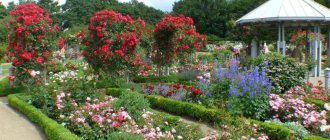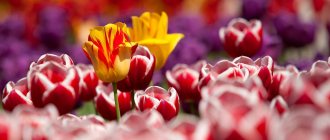Greetings, my dear readers! Today we will talk about flowers in the garden. I will tell you what flowers need to be planted on the site, how to arrange them correctly so that they look picturesque and not dull.
Flowers are a very powerful decorative and compositional tool. With their help, you can “organize” the territory, decorate the entrance to the garden and the house, and a relaxation area. It’s bad when flowers are scattered aimlessly around the area - they need to be placed so that the effect is greatest.
Principles for placing flowers on the site
Before you start placing flowers in your garden plot, make a plan and think carefully about what flowers you would like to see on your plot. And then decide where to place them:
- Don't try to use all the flowers you like on your site. Let your palette include flowers of different heights and flowering periods. Also plant several species with decorative leaves, it will be easier to create a composition.
- Flowers on the lawn should be placed like this: the tallest ones (delphinium, daylily) are planted in the center, slightly lower around them (phlox, foxglove), and the lowest ones (arabis, lily) are placed on the edge. This way you can place not only perennials, but also annual plants. You can choose other flowers in the same way.
- Excessive diversity tires the eye, and monotony creates a feeling of monotony. The most harmonious and visually pleasing color combinations are: orange with blue, yellow with blue, green with purple. Inharmonious colors are orange and red, blue and violet. The dominant tone in the plantings is green. Since it is the color of foliage and grass, it has the excellent property of unifying the entire composition. You can also use white and gray colors in the composition; they help separate inharmonious tones from each other.
- The first thing we do is choose the most advantageous place for flowers. We determine the species composition, the main color scheme. Also, do not forget about the timing of flowering. Arrange according to height.
You can find out the soil, nutrition, and how they relate to possible shading yourself from various sources, so experiment and find suitable solutions.
Flowerbeds for the lazy with the most unpretentious flowers
We looked at several options for creating the most popular flower beds.
Each of them deserves to be on your summer cottage.
But to be honest, it takes time, effort and some knowledge.
What if there is no such possibility?
This, of course, does not mean that you should not work with flowers and try to create little corners of paradise. You just need to go the simpler route until you have enough experience.
One of the solutions to this issue is shown in the video, in which the author shows how to create a flower bed that blooms all season long using simple means.
You can find out which unpretentious flowers, both annuals and perennials, are worth planting in your dacha from the article “The most unpretentious flowers for the dacha: 50 proven options.”
What is a front garden?
A front garden is a small fenced garden in front of a house. A very beautiful area of green lawn in front of the house, decorated with ornamental shrubs or a bright spot of flowering plants. These could be rose bushes, several tuberous begonias, a small flower bed of annual flowers of one or two colors. A low coniferous plant (thuja, juniper) looks very beautiful on the lawn. You can put an uneven stone - a boulder - next to it. There can be many options for a front garden.
But the main thing is not to overload it, not to cover the windows with greenery, not to arrange a pile of a wide variety of plants. The most commonly used flowering shrubs are lilac, jasmine, and spirea.
Examples of beautiful flower beds at dachas
And now I suggest you look at several examples of the implementation of various flower beds in summer cottages. All of them are feasible for independent repetition. Although, of course, you will have to work hard.
Flower beds
A flowerbed is a small piece of land of regular configuration (circle, ellipse, oval, rhombus, square, etc.), on which flowering and ornamental plants grow. Once upon a time, flower beds were common in the design of plots. They were made of arbitrary sizes, flat or raised, and planted with various flowering plants.
Flower beds made from one species also look impressive, for example, small-flowered asters, ageratum, petunia, purslane.
Round or polygonal flower beds?
Many gardeners plant flower beds on their plots that have the shape of a circle or polyhedron. To make such a flower bed look attractive from all sides, plants should be placed symmetrically or in sectors.
Such flower beds may have certain shades of colors.
These can be flower beds with purple shades of flowers. In the center of such a flower bed you can place a herbaceous perennial that has a height of up to 2 meters. It could be a window sill. Next to it you can place nettle leaf bell, aconite and black cohosh. Just below we will place daylilies and irises . You can dilute them with astilbe.
If you prefer shades of pink and red, then you can choose hollyhock (mallow), daylily, garden geranium, irises and Carpathian bell .
I give only two examples. Then you can create your own flowerbed from your favorite flowers.
Perennials as a symbol of stability
If you don’t have time to annually change the composition of your flower beds and replant plants from place to place, it is better to stick to perennials, which, once rooted, will delight the eye for a long time. Recognized leaders among perennials are luxurious dahlias and fragrant peonies, which during their flowering turn flower beds into huge white-pink-red clouds.
Get ready for the aristocratic peony to decorate your area for 10 years or more. This dominant plant blooms vigorously throughout the summer, and the rest of the time its decorative function is performed by its dark, glossy greenery. Peonies are not capricious: in the fall it is enough to remove their above-ground part. There is no need to cover or wrap plants from frost so as not to damage the sprouts in the spring.
Peonies are not recommended for planting in places subject to high humidity and flooding: under the roofs of houses, under the crowns of large trees, in wetlands
Dahlias are perfect for individual plantings, for group compositions, and even for creating lush arrays. They love places that are well lit by the sun but protected from the wind. One of the conditions for planting is moisture-intensive, fairly fertile soil, as well as moderate use of organic matter (manure). Dahlias bloom towards the end of summer, so flower beds can be supplemented with shorter plants.
The roots of dahlias need additional air flow: by regularly feeding and watering the flowers, it is necessary to loosen the soil and remove weeds
Read more in the articles:
What is a mixborder?
Mixborder is an area (limited area) where ornamental plants are grown. They are most often herbaceous flowering plants, but shrubs and small trees may also be present. How can you add spatial depth to a flower garden? To do this, plants with large flowers are placed in the foreground, and plants with small ones in the background. The width of the mixborder should be no less than the height of the largest plant. In other words, if this is not done, the composition will not be proportional.
A barberry bush with daylily and cereal herbs looks good, and meadow cornflowers can be added to the lower tier.
You can also take low-growing coniferous trees and add peony and rose bushes to them.
Hydrangea will look good with phlox, and for framing you can take petunia or marigolds.
In the partial shade under the crowns of young apple trees, plums, bird cherry, sea buckthorn, aquilegia, astilbe, hosta, milkweed, swimweed, bellflower, saxifrage, sedum, aruncus, cuff, tenacious grow and bloom beautifully. Meanwhile, plants with light leaves or flowers “highlight” the most shaded areas. Many annuals and biennials are suitable for this. They can be planted with perennials in small quantities.
There are many options, it just all depends on you and your imagination.
Creating flower beds in the country
There are quite a lot of principles for creating flower beds. Often they are not similar to each other and even contradict each other in some way. But the main thing that distinguishes them from arbitrary planting is some kind of idea embedded in them, meaningfulness. If these components are present, then your guests will feel it, even without your comments.
And so, let's look at a few principles for creating a beautiful flower garden in the country.
However, this approach is applicable not only for a summer house, but also for any personal plot.
Mixborder: types and features
Let's start with one of the most common types of flower gardens - mixborders.
This flower bed has an elongated shape. The name is translated from English as “mixed border”.
Of course, you probably arranged these or similar flower beds on your site, perhaps without knowing their correct name. Now we will talk about them in more detail.
Mixborders can be one-sided or two-sided.
One-sided mixborders are usually installed along walls, fences, and garden paths. In this case, the flowers should be planted in such a way that the tallest ones are located in the background and create a background, without covering or shading the low-growing flowers.
It makes sense to install double-sided mixborders in an open space when the flower garden can be viewed from different directions.
Plants, depending on their height, are arranged in a similar way. That is, in the middle are the tallest, and after them the rest in descending order of height.
If a one-sided mixborder is designed to decorate a specific area, for example, near a house, then a double-sided mixborder, on the contrary, can be an excellent tool for separating two different zones on a site.
Plants for mixborders can be selected in a variety of ways, both annual and perennial. You just need to try to ensure that their flowering period occurs at different times. Then such a flower garden will remain beautiful and elegant all summer, and even September.
The width of the mixborder is usually from one and a half to two meters. Therefore, it should not be confused with another type of flower garden - a flower border, the width of which is 30-50 cm.
Mixborders are divided not only by shape, but also by the type of plants used.
Let's look at a few examples.
Meadow mixborder style
This mixborder is characterized by simple, common plants such as poppy, flax, chamomile, snapdragon, zinnia and of course meadow grasses and cereals.
This flower garden resembles a Moorish meadow. The only difference is in its tiered arrangement of plants.
English mixborder style
A characteristic feature of this flower garden is restraint and severity.
When forming, preference is given to shrubs with narrow, elongated leaves in combination with beautifully flowering perennials.
The highlight of the English mixborder is the harmonious combination of wild and garden plants. This can be wormwood, speedwell, lavender, salvia, delphinium.
Rustic mixborder style
If you want to create an atmosphere of home comfort rather than strict aristocracy, then this flower garden style will be a good solution.
When decorating a flower garden in this style, plants characteristic of rural areas are used. This could be tagetes, mallow, nasturtium, cornflower, sedum. From shrubs you can use viburnum and even currants.
Mixborder garden style
Yes, there really is a garden or vegetable mixborder style.
This mixborder is made, as the name implies, from vegetable plants, as well as spicy and medicinal herbs.
Sunflowers and Jerusalem artichokes are suitable for the background of such a composition. But further on there may be various types of cabbage, beans, mint, parsley, thyme, lemon balm.
Such a mixborder would be appropriate, for example, in a small area. It will turn out both beautiful and useful.
And in conclusion, let's look at an example of what plants can be used in a mixborder so that it blooms long and evenly, delighting us with its attractive appearance.
It should be noted that when planting plants in a mixborder, there is no need to strive to maintain any clear order, much less symmetry or alternation of colors. You can plant, in general, arbitrarily, paying attention only to the height of the plants. As stated earlier, low-growing plants should be placed in the foreground.
I think we’ve talked enough about mixborders, we’ve gotten the first idea of how to plant beautiful flowers in the country, so it’s time to move on to the next type of flower beds.
Discounts - what is it and what are they?
Now let's look at another popular type of flower garden - rabatka.
But first you need to figure out what a rabatka is, what it looks like and what its distinctive features are.
This is a flowerbed in the shape of a regular rectangle 50-200 cm wide. The length of the flowerbed may not have restrictions, but its minimum length should be three times the width.
A distinctive feature of a rabatka, in comparison, for example, with a mixborder, is that the plants are planted in a certain sequence, forming some kind of pattern, most often symmetrical.
Another difference between a rabatka and a mixborder is that the plants are used at almost the same height.
It’s clear that on a plot of six acres you can’t really go wild and build a ridge of infinite length. But this is not required. A width of 80-100 cm and a length of 3-4 m is sufficient.
By the way, one should not confuse the ridge with a flower border, the width of which is no more than 50 cm and only 1-2 types of plants are used.
Above, I indicated that the discount has the shape of a regular rectangle.
Yes, most often this is true. But there are also exceptions. If, for example, such a flower bed is located along a smoothly curving path, then its shape will also be curving. But the width should still remain the same.
Most often, ridges are located parallel to the paths, or serve to separate zones with different purposes on the site.
Let's look at a few examples of flower beds called rabatka.
By the way, translated from German, rabatka means, alas, a garden bed. Well, in shape it really does look like a garden bed.
What plants are best to use when creating a ridge?
As mentioned above, there is some kind of ornament in the discount. And in order for this ornament to look more clear, ground cover plants are used as a background, and brighter plants of slightly higher height are placed on it.
The following can be recommended as ground cover plants: stachys, jasmine, saxifrage, loosestrife, tenacious and others.
Of course, when creating a border, more imagination and accuracy are required than in the case of a mixborder. But the result can be impressive.
Now let's move on to the next type of flower garden.
Rock garden or alpine slide
Of course, this element of landscape design is also worth mentioning briefly.
Alpine slides on the site are created either artificially by pouring soil, or using natural hills, if any.
But in any case, two components must be present: stones reminiscent of mountainous terrain, and mountain vegetation between these stones.
Properly constructed alpine slides look very impressive, especially if they correspond to the general design style of the site.
I will not describe in great detail the technology for creating an alpine slide and list plants suitable for this for the reason that I already have an article on this topic. I recommend reading it, and it’s called “Do-it-yourself Alpine slide on a small plot.”
What is a discount?
The ridge is formed by plants planted in the form of a narrow long strip. They are usually located on the sides of the path leading to the house or along the fences near the house. The length of such a strip is 2-3 meters, the width is usually 50-100 cm. Aligned plants that bloom for a long time are planted at work. It can be:
- annuals - marigolds, ageratum, alyssum, lobelia, zinnia;
- biennials - viola, daisy;
- perennials - iris, phlox, astilbe, hosta, pelargonium, etc.
Sometimes the main plantings in the work are “knocked out” with a border.
A border is a narrow strip of lower plants (flowering or decorative foliage). Plants are selected so that they bloom at different times.
You can also plant spring flowering plants at work. These could be tulips, daffodils. After they bloom, they are dug up and their place is taken by annuals or perennials. These can be such as tuberous begonia, heliotrope, pelargonium or marigolds and ageratum.
A mixed border will look much more picturesque. But to design it you need to spend more effort and imagination. Plants should be selected in such a way that they bloom at different times, so that the group looks more elegant. The first row is planted with shorter plants, and taller ones in the back.
Continuous flowering garden of perennials
A flower garden of free-form perennial plants, a real decoration of the garden, requires the least care and attention. How to decorate it beautifully with your own hands?
To prevent mistakes, you must:
- make a list of plants indicating their flowering period (summer, autumn flowers or blooming all summer)
- draw a planting plan taking into account the height and width of the bush of each specimen
- mark a place for a flower garden on the site and evaluate it from the point of view of visibility and background
The most popular perennial bulbous plants begin to bloom in the garden in spring: these are unpretentious flowers that reproduce quickly and easily. As a rule, small-bulbous plants (scillas, quinodoxes, snowdrops, white flowers, crocuses, muscari) do not need to be dug up after flowering; they only need to be replanted once every few years. Bulbs are planted in large groups, preferably at least 50 pieces, so that the flowers form a bright spot.
Rockery - what is it?
A rock garden is a small rocky garden located on an area where all the elements of the landscape meet in a limited area. Many different plants are suitable for rockeries, adapted to different conditions and requiring different care. You can create a miniature landscape to suit every taste. Any plant with creeping stems can be planted in a gap between stones in a sunny place.
Plants suitable for creating rockeries are meadow geranium, Japanese primrose, saxifrage, thyme, Iberis. You can also plant bellflower, yarrow, irises, immortelle, alyssum, and St. John's wort. In addition to those mentioned above, you can use many other plants that are adapted to different conditions and require different care. A rockery can be arranged in any corner of the garden. The only condition is that if you place it on a hill, then the hill should be oriented to the south or southeast. It is known that most alpine plants love the sun.
More attention should be paid to the location and shape of the stones. Shapeless blocks are preferable to smooth, round boulders. The stones are arranged so that their lower part descends to the foot of the rockery. Some stones can be partially buried in the ground. Do not pile up too many stones, simplify the layout of your rock garden as much as possible, and provide easy access to all its corners. After installing the stones, you can begin planting.
Color combination scheme
If you draw an equilateral triangle inside the diagram, then the colors that are at the top of the corners are combined brightly and contrastingly, even if the shades chosen are pale. Opposite colors are also contrasting.
If you choose shades lying next to each other on the circle, you will get a calm and discreet combination.
The type of flower garden in landscape design is largely determined by:
- the place where it is supposed to be placed,
- available area,
- background (fence, lawn, house, etc.)
- point of view.
Alpine slide in the garden plot
An alpine slide is one of the landscaping techniques that is created on level ground or a small hill, using stones of various sizes to imitate mountain slopes on which dwarf shrubs and perennial flowers grow.
.
In a small garden you can arrange a picturesque group of low, creeping perennial plants. Such plants, as a rule, come from mountainous areas and, therefore, they must be planted on a rocky (alpine) hill. The height of the slide depends on the area of the site and the artistic design. The stones (it is better to take large rocks) are placed in steps so that they form pockets. Soil is poured into these pockets. For stability, stones are buried halfway into the ground.
Plants are planted in small groups, making sure that they blend harmoniously with each other. In the upper part of the hill you can plant sedums (sedum), juniper, jasmine, Crimean edelweiss, saxifrage, and bells. At the bottom of the hill you can plant larger flowers. These can be bergenia, low irises, low shrubs (cotoneaster), wild tulips.
Plants are selected so that they bloom continuously throughout the season. Those species that look quite decorative even without flowers look especially good, thanks to the dense pubescence of the foliage. It will be even better if there is a waxy coating on the leaves of these plants. And these leaves will have a peculiar shape.
It is better to place the alpine slide on the south side of the site. There the sun will illuminate the hill for a longer time.
Unpretentious plants for beginner gardeners
Many lovers of country holidays visit their dacha only on weekends, therefore, they need to choose flowers that require minimal care. In addition, plants must be able to withstand drought or, conversely, prolonged rain. If you plant capricious roses in more northern latitudes, they will require daily attention, so let’s consider options that quietly develop on their own, at least within a week.
Yellow and orange marigolds are also undemanding to soil. The only condition for their successful cultivation is a sunlit place, and this can be a patch in the middle of the lawn, a narrow flowerbed along the path, or containers hanging from the wall. Low varieties of marigolds are ideal for creating ridges or borders.
Bright, monochromatic marigolds look more elegant when surrounded by plants with decorative large leaves, for example, against the background of an ordinary or spotted hosta
Climbing, freedom-loving nasturtium is perfect for lightly shaded areas. It grows quickly, so it should be planted in areas with plenty of free soil. In order for the nasturtium bush to retain its shape and size for as long as possible, it is placed in a pot or small container. Early May is the best time to sow these pink, burgundy, lilac, yellow or variegated plants.
Imopoeia is distinguished by its large flowers, noticeable from afar, which can decorate both the wall of a house and a trellis specially constructed for it. Imopoeia loves support and has increased tenacity, so it can easily “pounce” on any object standing nearby - a bench, a tree, a corner of a house. These beautiful flowers with large buds love sunlight and organic fertilizers.
A special feature of growing nasturtium is the dosed application of fertilizers. A large amount of mineral substances will cause rapid growth of leaves, but will suppress the formation of inflorescences
Two or three varieties of imopoeia with buds of different shades, planted near a trellis, arch or trellis, look original and harmonious.
Lawn on a garden plot
Recently, having a lawn in your garden has become a fashionable phenomenon.
A lawn is a piece of land with an artificially created cover of herbaceous plants.
Grass cover can be created by sowing seeds of specially selected grasses. Often it can serve as a background for decorative plantings. The lawn usually occupies the space from the wall of the house to the border of the garden. It can be located under ornamental trees, shrubs and between them. The lawn can only be interrupted by a path, border, work, benches and other buildings intended for recreation.
An ideal lawn should consist of plants with a fine, dense grass stand. Such herbs are not usually found in nature. Such a lawn can only be created by a certain selection of plants. And such plants require good care.
The garden lawn should be mowed 12-20 times per season. And it should be watered the same number of times. The lawn should be mowed at least 4-5 cm. Lower mowing weakens the plant. When mowing to a height of 3 cm, the lawn of bluegrass and red fescue thins out. It is recommended to mow the lawn to the same height only in summer. In dry weather, it is mowed higher to reduce watering. It is also recommended to mow the grass higher under trees in the shade, since the roots of the trees take a lot of moisture from the lawn.
In sunny weather, the lawn should be mowed in the evening and watered immediately. It is necessary to mow when the grass reaches 6-7 cm. In the spring, the interval between mowing is 4-5 days. In summer, these intervals increase and amount to 11-15 days. In autumn they shrink again. The last mowing must be planned so that the grass grows 7 cm before frost. It is not recommended to leave grass on the lawn. It’s better to immediately run away after mowing and compost it.
Sowing seeds in pots
It is recommended to sow flower seeds in pots taking into account these recommendations:
- Marked and prepared beds for planting seeds in open ground are recommended to be filled with humus (6-8 kg/m2), superphosphate (30-40 g) and potassium sulfate (10-15 g/m2);
- Peat and sawdust are added to heavy soil, and acidic soils are limed;
- In early spring, nitrogen fertilizers are applied - ammonium or sodium nitrate in volume (20-30 g/m2);
- If no fertilizers were applied in the autumn, then in the spring a full range of organic and mineral fertilizers are added to the soil.
Tip: In order to protect the delicate seeds of flowering plants from the cold, beds with sowing small seeds are covered with paper or film, which is pressed down at the edges with lumps of earth. With such temporary protection, seedlings appear more actively and evenly.
However, it must be taken into account that when using film protection it is very important to remove the film in a timely manner. Otherwise, the sprouts will become very elongated. The shelter should be removed in the evening and immediately water the crops through a fine sieve.
Sow seeds in pots when the seedlings do not tolerate transplanting. In such cases, it is very convenient to sow seeds in peat pots (several seeds in each). The pots should initially be kept in boxes indoors, in a greenhouse, under film. When the plants grow (but do not stretch out) and the danger of frost has passed, the sprouts along with the pots are planted in the ground in prepared places at the required distance.
Nuances of watering
Before planting, plants in peat pots should be thoroughly watered so that the peat from which the pots are made is well saturated with water. The holes prepared for planting also need to be well watered.
Next, the pots are buried, lightly pressing into the ground. When the plants take root in the open ground (after 1-2 weeks), they are thinned out, leaving 2-3 pieces in the nest.
The good thing about the method of sowing seeds in pots is that you don’t have to weed and water the entire garden bed while waiting for germination. Flowering of plantings, when using this method, occurs earlier and seed consumption is sharply reduced, which is especially important if these are valuable seeds and there are few of them. Seedlings in pots will also be very convenient to use for decorating flower beds and ridges.
Did you find this article helpful? Please share it on social networks: Don't forget to bookmark the Nedvio website. We talk about construction, renovation, and country real estate in an interesting, useful and understandable way.
Decorative planting in the garden
To choose one or another method of planting garden plants, you will not only have to look at beautiful illustrations in specialized catalogs, but also learn about the features of forming landscape groups. To plant flowers in the garden as your imagination dictates, good taste is not enough.
It is necessary to follow the rules of compatibility, because some crops can suppress others or bloom at the same time, and for the rest of the time your plot will seem empty.
Even beautiful and well-groomed plants, chosen in accordance with the natural conditions of the site, will not make a good impression if they are planted in disarray, without taking into account the decorative features of each species.
There are several basic ways of planting flowers, and for each type of composition, plants are selected in a special way. The height, shape, flowering time, and development during the summer season are taken into account.
You will learn how to plant flowers in the garden correctly and beautifully by reading this material.
Interesting ideas for planting flowers in an array in the garden
Large groups of plants, the length of which exceeds the height multiplied by three, are called arrays. They look completely different from regular groups. The array forms a continuous homogeneous surface at the level of plant height.
If these are low flowers, such as tulips, the surface of the array extends close to the ground. If the stems of plants rise to a height of one and a half meters or higher, the beauty of the massif can only be appreciated from an elevation - up close it appears as a solid wall.
An array, like a group, can be composed of several types of crops, but it should be remembered that individual specimens are not visible in such a composition.
We do not perceive each plant in particular, but the entire mass of leaves or flowers, so an array made of small groups most often does not make the right impression. Plants of the same species, planted in large “spots,” look better.
These photos show how you can plant flowers in the garden in arrays:
Pots for plants.
Before planting houseplants, you must prepare. You should already have the appropriate pot. It depends on the size of the plants and your preferences. Pots come in different colors and are made from different materials. Clay pots are durable, but heavy and not always attractive. Plastic ones are lighter and have a wider range. Variety of colors and sizes.
You can choose the right size pot by knowing the soil of the plant you purchased or need to plant. The pot should be slightly wider than the previous one in which the plant grew. Plants are sold in small plastic pots - these are transport pots. They grow plants for sale. It is not recommended to further grow plants in such pots. The choice of pots for indoor plants is very large. Some prefer clay, others plastic. Self-watering pots are very convenient, but their cost is much higher than usual. Try to match the pots to the interior of your home; it’s better when they are all in the same style.
I use the lunar calendar, you can choose favorable days for planting indoor plants. The most favorable day for planting is the waxing moon.
Caring for flowers in the garden
In order for a flower garden to delight all summer, it requires regular care, which consists of watering, weeding, loosening and fertilizing the plants. In the spring, nitrogen is applied to the perennials twice, with an interval of three weeks, and during the budding period and in the fall, a complete complex fertilizer with a high content of potassium and phosphorus is applied.
When planting annuals that bloom all summer, the soil is usually well prepared and amended with organic fertilizer. If this has not been done, then the feeding scheme is as follows: during the period of intensive growth, nitrogen is added, and when the buds are laid and flowering begins, they are fed with complex fertilizer with a high content of phosphorus and potassium.
Some plants need pinching for better branching and the formation of side shoots. It is necessary to promptly remove faded inflorescences and set seeds, as their presence reduces the flowering period and the number of new buds. You should not wait for the inflorescence to completely wither; it must be removed as soon as the decorative effect begins to be lost.
In some plants, after a beautiful and spectacular flowering, the foliage turns yellow. It needs to be removed. Bulbs of tulips, daffodils, and hazel grouse are dug up and dried.
Large tall plants or plants with spreading aerial parts are tied up so that they do not break or fall apart from the wind.











